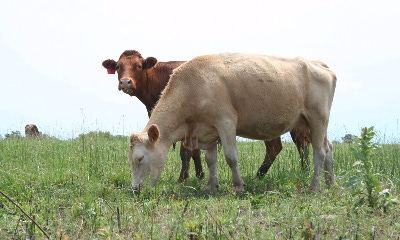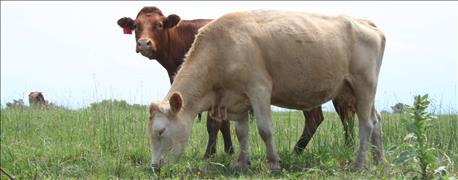March 29, 2016

Missouri is a beef state. Its No. 3 ranking in U.S. cattle numbers depends on good grass. Cows and grass: Can't do one without the other.
University of Missouri programs are in place to improve both genetics of calves and beef gains from an acre of grass.
A beef cow's rumen converts inedible cellulose into high-value protein. Premium beef grows best on quality, toxin-free, grass.
A new "Missouri Beef Value-Added Study" devotes a major section to tall fescue yields. Eliminating toxic fescue plays a big part in boosting value-added beef.
Beef summit started study

COUNT ON GRASS: Improving Missouri's grass pastures is one way to increase value to the state's beef industry.
This story starts with the Governor's Beef Summit at MU in early 2015. Recognizing the dollar impact of cows on the state's economy, industry leaders met to discuss how to add value.
Answers are in a 97-page book by a team of MU Extension specialists. The Missouri Agricultural & Small Business Development Authority in the Department of Agriculture funded the study.
That report, of value for every beef farmer, may be an eye opener for most.
The report looks at three parts: Cow-calf, stocker and fed cattle. January 2015 that breakdown was 80.5%, 14% and 2%, respectively. Dairy made up another estimated 3.5%.
At the Summit, a wrap-up panel surmised that Missouri beef producers know how to do better than we are doing. Let's improve.
Heifer genetics dollars
On the beef side, major advances have been made in recent years in heifer breeding and management. The Show-Me-Select Replacement Heifer program led the way. Many more than those who enroll use the protocols for herd improvement. Genetics plus management leads to better heifers and premium grade steers.
On the grass side, progress hasn't been as fast. The value-add study on the forage side highlights what can be done by removing fescue toxicosis.
~~~PAGE_BREAK_HERE~~~
Educational efforts have been led by the Alliance for Grassland Renewal. It has taught four one-day schools a year on renovating pastures from toxic Kentucky-31 to novel-endophyte fescue varieties.
After three years, progress inches up. Conversions are underway. Renovators look in wonder at improved results. But, this year, the fourth school at Linneus was cancelled for lack of enrollment.
Book collects value ideas
The value-add book provides a service by outlining the potentials. The authors point out: Despite several fescue toxicosis management tactics available, producers have limited experience with those options.
Practical Missourians developed many work-around practices to reduce toxicosis impact. That includes mixed grass pastures; adding legumes in pastures, feeding supplements, avoiding toxic fescue hay, grazing non-toxic fescue, grazing K-31 at less toxic times, removing cattle from fescue in heat of summer. There are more.
The Alliance schools teach replacement. Toxic grass is eliminated with the MU developed 'spray-smother-spray.' That involves spraying the toxic fescue, then planting a cover crop. That shades out emerging tillers arising from the soil seedbank. The smother crop can be grazed. Then the cover is killed by the second spray. Finally, farmers fall plant with no-till drill q new novel-endophyte into the cleaned pasture.
One-time deal, not annual cost
Some farmers object to the labor and cost. But, advocates say that is a one-time deal. The work arounds take time, labor and money every year.
The economics are told in the value-add book available online at beef.missouri.edu
You May Also Like




